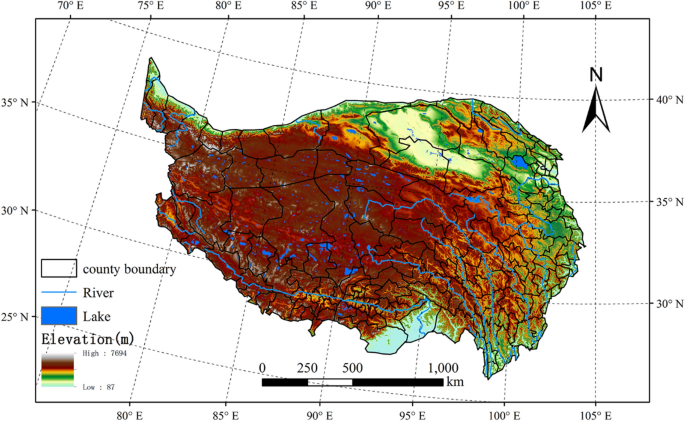[ad_1]
Study area
The QTP is located in southwestern China (25° ~ 40°N, 75° ~ 103°E), with a total area of 2.5 million km2 and an average elevation above 4000 m (Fig. 7). The QTP is mainly covered with permafrost and grassland, with areas of glacier and desert48. The QTP, also known as the “Asian Water Tower”49, is the source of 13 major Asian rivers (e.g., the Indus, Ganges, Brahmaputra, Yangtze, and Yellow Rivers). The QTP has a clod, arid climate, with an annual average temperature below 0 °C and an annual mean precipitation of 400 mm. The seasonal distribution of precipitation is uneven, with most precipitation concentrated in the period June to September. There is a decreasing trend in precipitation from the southeast to the northwest of the plateau50. Known as the “Roof of the World” and “Third Pole”, the QTP is also an area that is sensitive to global climate change, showing increasing warming and humidification in recent decades51. In addition, the QTP contains a diversity of ecosystems and fosters a historic ecological security barrier, which nurtures the development of animal husbandry and diverse cultures.
Geographical location of the QTP. The map was created using ArcMap 10.2, URL: http://www.esri.com.
Data sources
RCP scenarios and climate change dataset
The RCP scenarios released by the IPCC 5th Assessment Report52 supply a forecasting standard for climate change research. RCP values ranging from 2.6 to 8.5 reflect radiation forcing values in 2100 relative to the beginning of the Industrial Revolution in 175053. Different radiative forcing scenarios represent different future climate scenarios. RCPs consist of one high-emission scenario (8.5 ({text{W}} cdot {text{m}}^{ – 2}), RCP8.5), two medium-emission scenarios (6.0 ({text{W}} cdot {text{m}}^{ – 2}), RCP6.0; 4.5 ({text{W}} cdot {text{m}}^{ – 2}), RCP4.5), and one low-emission scenario (2.6 ({text{W}} cdot {text{m}}^{ – 2}), RCP2.6)54. In this study, we adopted the RCP2.6, RCP4.5 and RCP8.5 climate change scenarios choosing RCP4.5 to represent the medium emission scenario in consideration of increasing activity through global initiatives in response to climate change. Specific descriptions of each scenario are shown in Table 1.
We adopted the climate change dataset outputs from five global circulation models(GCMs) (namely GFDL-ESM2M, HadGEM2-ES, IPSLCM5ALR, MIROC-ESM-CHEM, and NorESM1-M) within the fifth phase of the Coupled Model Intercomparison Project (CMIP5)55. The dataset outputs from GCMs were downscaled to a resolution of 0.5° and bias-corrected with Water and Global Change (WATCH) data (Integrated Project Water and Global Change, http:/www.eu-watch.org/data_availability)56. The baseline period of the dataset is 1950–2005 and the forecast period is 2006–2099.The climate change dataset included daily precipitation, air pressure, solar radiation, air temperature, maximum air temperature, minimum air temperature, wind speed, and relative humidity.
Auxiliary data
The auxiliary data for our research include the following. (1) The land use and land cover (LULC) map was obtained from the Resource and Environment Science and Data Center (RESDC), Chinese Academy of Sciences (https://www.resdc.cn) for 1980, 1990, 1995, 2000, 2005, 2010, 2015 and 2020 at a 1 km resolution. The LULC data have six major classes: cropland, grassland, forestland, water, built-up land and barren land. (2) The spatial distribution of soil type data, digital elevation model (DEM), watershed boundaries and normalized difference vegetation index (NDVI) data with a resolution of 1 km were obtained from the RESDC. (3) Soil physical and chemical property data (available soil water capacity, absolute depth to bedrock, silt content, clay content, sand content and soil organic carbon content) were obtained from the International Soil Reference and Information Centre (ISRIC Data Hub) (https://data.isric.org) with a 1 km spatial resolution. (4) During 1986–2005 and 1986–2098 (RCP2.6; RCP4.5; RCP8.5), the permafrost datasets in the Northern Hemisphere (https://doi.org/10.12072/ncdc.CCI.db0032.2020) and the response of the alpine grassland ecosystem to climate change (RCP2.6, RCP4.5, and RCP8.5) in the permafrost region of the Qinghai-Tibet Plateau from 1981 to 2099 (https://doi.org/10.12072/ncdc.CCI.db0006.2020) were provided by the National Cryosphere Desert Data Center (https://www.ncdc.ac.cn).
Future land use simulation and validation
In this study, we used the Future Land Use Simulation model (FLUS) to simulate the LULC in 2030, 2050 and 2100 under the three RCP scenarios. This model was developed by57 and is available for download at (www.geosimulation.cn/flus.html). The FLUS model is an efficient land use simulation tool and has been widely used58,59. We selected the DEM, slope, precipitation, temperature, soil type, and permafrost distribution to calculate the suitability probability. Based on the land use transfer from 2010 to 2015, we calculated the total land use in 2030, 2050 and 2100 under three RCP scenarios by the Markov model. To validate the FLUS model, we set 2010 as the starting year and simulated the land use in 2015. The output results were compared with the real 2015 land use data, and we calculated the Kappa coefficient as follows:
$$begin{array}{*{W}c} {Kappa = frac{{P_Under climate change scenarios, dynamic characteristics and synergistic effect of ecosystem services on the Qinghai–Tibet Plateau – P_{C} }}{{P_{P} – P_{C} }}} end{array}$$
(1)
Where (P_




